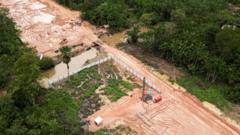A new four-lane highway is carving through the protected Amazon rainforest to facilitate the upcoming COP30 climate summit in Belém, Brazil, raising significant environmental concerns. Spanning more than 13 kilometers, the highway construction is intended to ease traffic for the estimated 50,000 attendees, including world leaders, expected at the event in November. Despite claims of "sustainable" development from state officials, local residents and conservationists are expressing outrage over the extensive deforestation it entails.
The Amazon rainforest, crucial for global carbon absorption and biodiversity, is being compromised, arguably contradicting the very objectives of a climate summit. Locals like Claudio Verequete, who lost his source of income after açaí berry trees were removed, voice fears of further environmental degradation if the road opens access to businesses seeking to exploit the land. "Where are we going to go?" he questions, highlighting the uncertainty faced by residents as they confront changes brought by the road.
The highway threatens not only the livelihoods of local communities but also the ecosystem itself. Wildlife experts warn that the construction will hinder the movement of animals, disrupting their natural habitats and breeding grounds. "From the moment of deforestation, there is a loss," says Prof. Silvia Sardinha, a wildlife vet concerned about the implications for local wildlife rehabilitation efforts.
Government officials assert that the summit presents a unique opportunity to focus on protecting the Amazon rather than merely discussing it. Nevertheless, community members feel their voices are being overlooked amidst high-level discussions focused on infrastructure development, which includes wildlife crossings and solar lighting, as well as investments in tourism facilities to accommodate visitors.
While some local business owners anticipate economic growth from the developments, others remain skeptical about the long-term impacts of such construction projects on the environment and their own livelihoods. As preparations for the summit proceed, the mix of hope and skepticism showcases the challenge of balancing development with ecological preservation in one of the world's most biodiverse regions.
As scrutiny grows regarding the environmental toll of bringing thousands of delegates to the summit, the path ahead remains fraught with tension between progress and preservation.




















